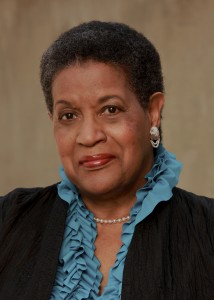About Us
About Dr. Myrlie Evers-Williams

Born as Myrlie Louise Beasley on March 17, 1933, in Vicksburg, Miss., Myrlie Evers-Williams was raised by her paternal grandmother, a retired school teacher.¹,² She was surrounded by a family of educators where she developed a love for learning.³
In 1950, she attended Alcorn A&M College majoring in education.1,2 She met a young activist, Medgar Evers, on her first day on campus.2 After marrying Mr. Evers in 1951, she would leave college to relocate to Mound Bayou, Miss., where their first two children, Darrell Kenyatta and Reena Denise, were born. Serving as vanguards for political activism during the Civil Rights Movement, the young couple would organize the National Association for the Advancement of Colored People (NAACP) branches in the Mississippi Delta to boycott businesses which discriminated against African Americans.1 In 1954, the couple would relocate once more to establish a NAACP field office in Jackson, Miss., becoming the target of numerous death threats and acts of violence.1,4 Three years after the birth of their second son, James Van Dyke, Mr. Evers would die tragically on June 12, 1963.2,3
Moved by the death of her husband and a desire to continue his legacy, Dr. Myrlie Evers-Williams created her own path dedicated to a life of service. Dr. Evers-Williams began to emerge as a national catalyst for change and equality as she traveled the country speaking out against racial and economic injustice.4 After relocating to Claremont, Calif., in 1964, Dr. Evers-Williams continued her studies at Pomona College where she earned a sociology degree four years later at the age of 35.2,3 In 1967, she co-wrote For Us, the Living, a moving account of her life with Mr. Evers and his heroic efforts to achieve civil rights for all.2 She later became the first black female to lead the Southern California Democratic Women's Division.5
In 1973, Dr. Evers-Williams began her corporate career for a New York-based advertising firm, Selligman and Latz, Inc., as the vice president for advertising and publicity. Two years later, she began a 10-year career with Atlantic Richfield Co., an American oil company, as a national director for community affairs and later the director of consumer affairs.3,5 In 1976, she married Walter Williams, a labor organizer and civil rights activist.2 For 18 years, the couple would champion the causes of equal rights until Mr. William's death in 1995 of prostate cancer.6,7 In 1987, she became the first African-American woman commissioner for the Los Angeles, California Board of Public Works and a national board member of the NAACP.2,3,5
Longing for justice in her first husband's death, Dr. Evers-Williams successfully fought for a third trial and subsequent conviction of his assassin in 1994.2,3 After being elected the first female chair of the 64-member Board of Directors of the NAACP in 1995, Dr. Evers-Williams worked tirelessly to improve the organization's image and retire a debt in the amount of $4 million.3 By 1998, the NAACP was financially stable and Dr. Evers-Williams decided against re-election to refocus her energy.2,7 The same year, she established the Medgar Evers Institute in Jackson to increase educational and economic development opportunities for the underserved.4,7 Fourteen years later, the institute was renamed as the Medgar and Myrlie Evers-Williams Institute.2 Dr. Evers-Williams currently serves as the chairwoman of the Medgar and Myrlie Evers-Williams Institute.
Dr. Evers-Williams' commitment to education has been unyielding. In recognition of her stalwart leadership, she has received honorary doctorates from numerous higher institutions of learning including: Howard University, Medgar Evers College, Pomona College, Spelman College and two Mississippi institutions - Tougaloo College and Alcorn State University. 5,7 In 1999, her memoir was published. Watch Me Fly: What I Learned on the Way to Becoming the Woman I Was Meant to Be documents her path of despair and triumph as the wife of a civil rights activist to a well-respected and accomplished leader.3
Dr. Evers-Williams returned to her home state of Mississippi in 2012 to serve as a scholar-in-residence at Alcorn State University. In January 2013, Dr. Evers-Williams served as the first woman and lay person to deliver an invocation for the president of the United States.5 To honor the important legacy of Dr. Evers-Williams, the University of Mississippi Medical Center established the Myrlie Evers-Williams Institute for the Elimination of Health Disparities on June 13, 2014.6
References
1. Mississippi Department of Archives and History. (2002). Evers (Medgar Wiley and Myrlie Beasley) Papers. Retrieved from http://mdah.state.ms.us/new/research/collections/medgar-and-myrlie-evers-papers/.
2. Biography.com. (2015). Myrlie Evers-Williams Biography. Retrieved from http://www.biography.com/people/myrlie-evers-williams-205624
3. Washington University Film & Media Archive. (2015). Myrlie Evers. Retrieved from http://library.wustl.edu/units/spec/filmandmedia/collections/henry-hampton-collection/eyes1/evers_myrlie.htm.
4. American Program Bureau. (2015). Myrlie Evers-Williams. Retrieved from http://www.apbspeakers.com/resources/speakerpdf/18137.pdf.
5. Our Mississippi Magazine. (2014). Myrlie Evers-Williams: Named Our First Mississippi Lifetime Achievement Award Recipient. Retrieved from http://www.ourmississippimag.com/people/myrlie-evers-williams/#.VS1hM_nF98F. [linked to archived version]
6. Clarion Ledger. (2014). Myrlie Evers Sees Vision of Her Late Husband, Medgar. Journey to Justice. Retrieved from http://www.clarionledger.com/story/journeytojustice/2014/06/14/medgar-evers-walter-williams/10532219/.
7. National Association for the Advancement of Colored People. (2015). NAACP History: Myrlie Evers-Williams. Retrieved from http://www.naacp.org/pages/naacp-history-Myrlie-Evers-Williams.


